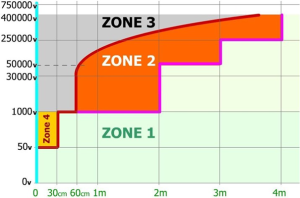Work zone and vicinity
Definition : The Vicinity Zone
The vicinity zone has been defined when a live part of an equipment is close to people. The distance between them depends of the voltage. In lower voltage (50 – 1000 V AC) this distance is 30 cm (11 in). It has also to be taken in account the possible movement of the worker, movement of live part (aerial wire), tools...
It has been defined that the accessible live part are equipment with:
In LV the IP is lower than IP2X
In LV the IP is lower than IP3X
Warning :
Work in a vicinity area requires the use of PPE and PEI.
Vicinity Zoneq
|






